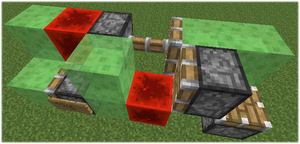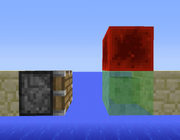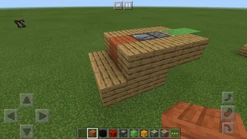(Just adding distinguishing.) |
(Adds block links with sprites.) |
||
| Line 1: | Line 1: | ||
{{cleanup|reason=make the page easier to read for Bedrock Edition users (more documentation, a separate section entirely?)}} |
{{cleanup|reason=make the page easier to read for Bedrock Edition users (more documentation, a separate section entirely?)}} |
||
{{distinguish|Elytra|Flying}} |
{{distinguish|Elytra|Flying}} |
||
| − | '''Flying machines''' are mechanisms that use |
+ | '''Flying machines''' are mechanisms that use {{BlockLink|slime block}}s and/or {{BlockLink|honey block}}s, movable power sources and {{BlockLink|piston}}s to move a [[player]], [[entity]] or structure in the air, liquids, or solid blocks. Part 1 of this tutorial discusses this mechanism as it works in ''Java Edition''. For Bedrock Edition designs use the contents bar. |
{{anchor|Using Slime Blocks}} <!-- compatibility anchor --> |
{{anchor|Using Slime Blocks}} <!-- compatibility anchor --> |
||
| Line 7: | Line 7: | ||
== Piston flying machines == |
== Piston flying machines == |
||
| + | The [[slime block]] based flying technologies use the clever placement of {{BlockLink|piston}}s, {{BlockLink |
||
| − | + | |id=block of redstone|blocks of redstone}}, {{BlockLink|observer}}s, {{BlockLink|slime block}}s and {{BlockLink|honey block}}s to make an engine, which will move the structure. This is another way of controlled flight in [[Survival]] mode, other than using an {{ItemLink|elytra}}. The two main components of slime block flying machines are the engine and the splitter. {{yt|hh2Mfh8MmWQ}}''Infinitely expandable flying machine with a 2-way engine and multiple splitters (each carrying 2 TNT Duplicators).'' |
|
These technologies use the fact that slime blocks will move adjacent movable blocks, including other slime blocks, when pushed or pulled. Honey blocks can also be used to bypass the piston push limit by using adjacent slime block and honey block flying machines to divide the number of blocks in a structure among pistons. |
These technologies use the fact that slime blocks will move adjacent movable blocks, including other slime blocks, when pushed or pulled. Honey blocks can also be used to bypass the piston push limit by using adjacent slime block and honey block flying machines to divide the number of blocks in a structure among pistons. |
||
Revision as of 22:49, 4 March 2021
Flying machines are mechanisms that use slime blocks and/or honey blocks, movable power sources and pistons to move a player, entity or structure in the air, liquids, or solid blocks. Part 1 of this tutorial discusses this mechanism as it works in Java Edition. For Bedrock Edition designs use the contents bar.
Piston flying machines
The slime block based flying technologies use the clever placement of pistons, blocks of redstone, observers, slime blocks and honey blocks to make an engine, which will move the structure. This is another way of controlled flight in Survival mode, other than using an elytra. The two main components of slime block flying machines are the engine and the splitter.
Infinitely expandable flying machine with a 2-way engine and multiple splitters (each carrying 2 TNT Duplicators).
These technologies use the fact that slime blocks will move adjacent movable blocks, including other slime blocks, when pushed or pulled. Honey blocks can also be used to bypass the piston push limit by using adjacent slime block and honey block flying machines to divide the number of blocks in a structure among pistons.
Engines

A simple flying engine. The central piston is the only sticky piston used in this configuration.
Engines are mechanical parts of slime-block based flying machines used to move them.
Engines divide into semi- and fully-automatic. The semi-automatic engines need player's intervention to move it, generally updating a piston (like using flint and steel on it or rapidly placing tripwire against it).
The fully-automatic engines are capable of automating the above issue, like by a piston next to it that extends and pushes the moving construction. However, to stop such an engine, something must be in the way so that it can no longer move, this may be in the form of a mechanism in the machine or some other immovable obstacle.
Engines can also differ in available directions and speed. Some can only move in a single direction. They are the most simple and most common engines.
Multi-directional engines
More rarely, engines can move in multiple directions. They have multiple piston mechanisms, each for movement into a separate direction. Such engines are often large and complex and require stations to reliably switch directions.
A 6-way engine that requires dedicated stations.
A 4-way engine (2 vertical directions) that switches directions upon contact with a few blocks.
Compact 2-way engine
A 2-way engine can be made with as few as 6 blocks – 2 Observers, 2 Slime Blocks, and 2 Sticky Pistons. Note that there is more than one way to make such an engine.
Its direction of flight depends on which observer is updated first. Note that in the diagram shown, each observer directly powers a slime block while its face faces up.
- Compact 2-way engine with honey block
A compact full-auto 2-way engine, where you can safely transport 2 players can be made with 14 blocks – 8 slimeblocks, 2 honey blocks, 2 sticky pistons and 2 observers.
Diagonal engine
Some engines can move diagonally by moving alternately along 2 axes .
Oblique engine
Slime block "knightships" (displacement (2m,m)) and "camelships" (displacement (3m,m)) can also be constructed, and further oblique flying machines are almost certainly possible to construct.
Turbo-charged engines

Slime-block engine A. Breaking the sign starts the engine.
Engine A is a high-speed single-direction engine. It fits into 2×2×6 dimensions and uses 14 blocks. Since zero ticking pistons is not possible on bedrock edition, this kind of flying machine will still be the same speed on bedrock edition as normal flyers, however, several 2.5 meters per second flying machines have been created for specific use on bedrock edition.
Note 1: This does not work in Java Edition 1.13 or Bedrock Edition (unless an observer-using variant is invented)
Splitters
Splitters are mechanical parts of a fully-automatic flying machine used to push an independent part of a large flying structure. A single piston only can push or pull up to 12 blocks. Splitters split a structure into multiple independent pushable parts (hence the name).
One-way splitters
A one-way splitter has 2 parts: a normal piston in the rear, and a slime block (or more) with a power source in the front with space between them.
Once the rear part with the piston is pushed, the piston will be activated by a power source from the front part. It will push the slime block (and thus the next part of the flying contraption and its splitters), which pulls the power source with it. The piston will then deactivate and prepare for another push.
Some simple engines are just made of looped splitters, such that, at any given time one piston is always powered (in these machines it is important to place the redstone blocks last).

A 1-wide splitter. The piston will be powered by quasi-connectivity.

An example of how splitters can be used to create more complex structures such as this train.
Two-way splitters
A two-way splitter consists of an observer powering at least one sticky piston which pushes or pulls a part of the flying contraption. This is possible only in Java Edition because it's the only version where sticky pistons (upon receiving a short redstone pulse) can push a block and then retract quickly without pulling it back.
This type of splitter will either continuously pull or push depending on whether the part it's supposed to move is initially retracted or not. If the part is initially retracted and the splitter is continuously pulled, the sticky piston will continuously pull the part. On the other hand, if the part is one block away ("not retracted") and the splitter is continuously pushed, the sticky piston will continuously push the part. This mechanism necessitates a switch within the flying machine to independently retract and extend the splitters before flight, because otherwise, the engine will most likely be unable to push due to the "stuck" retracted splitters adding extra load to the engine's pistons.
Harvesting
2-way Flying machine with long wings for Harvesting
Drivable flying machines
Falling hazard
Often due to lag, slime engines can bug allowing the player to fall through the machine. This can be solved by placing the player in a vehicle such as a minecart or by standing on top of a honey block.
Braking method
Starting the engine of a flying machine often involves updating a piston or observer. Braking, on the other hand, isn't as straightforward to do in survival because a piston-immovable block must be present to stop the engine. A reliable braking method that was first popularized by SethBling is to attach a noteblock (or any similar redstone component movable by pistons) to the "face" of an observer that powers a piston. The piston is placed on the front of the engine, and since extended pistons cannot be pushed by other pistons, activating the noteblock at the right time will stop the engine.
Brake component extension
By using sticky pistons instead of pistons for the braking components, they also become 2-way splitters. These can be used to carry extra blocks, such as holders for minecarts/minecart chests, passenger roofs, TNT duplicators, etc.
A modified version of the previous machine, with minecart chests and a roof attached to the 2 two-way spliiters.
A compact 4-way drivable flying machine that carries minecarts and minecart chests on its splitters. Flies North-South or East-West, depending on the placement of the two splitter pistons and two engine observers.
Bedrock engine designs
Flying machines are much more restricted in Bedrock Edition due to the lack of quasi-connectivity and other piston behaviors. In Java Edition, a sticky piston powered with a 1 tick pulse will drop the block it is carrying. The absence of these behaviors makes it difficult to create complex flying machines.
Simple engine 1
These are basic flying machine designs. The shown examples will move to the viewer's left.
Removing the block of redstone, or placing obsidian in front of the observer, will cause the machine to stop. This may be hard to do, unless in creative mode.

Simple engine 1 design, with added woodwork forming a gondola for the player. To start and stop, add or remove a piece of wood (such as the piece of acacia wood shown here).
For players who want to ride their flying machine, it may be hard to add and remove the obsidian or redstone block (especially in survival mode). A slightly easier way is to add layers of another material (such as wood plank) to the machine, stopping just before the limit of what a piston can move and doubling as a practical gondola for the player at the same time. From a position sitting on the machine somewhere, the player may add another wood plank block to the machine, killing the speed. Removing the final block causes the machine to start again.
Simple engine 2
The simple engine 2 provides a narrower but longer design, which requires less redstone than others (less redstone blocks). In this example, the machine would begin moving to the left once the observer on the right is activated. This can be done with a redstone pulse, or just lighting the face with flint and steel.
To reverse the direction of this machine, simply move one of the slime blocks to the back, and switch the piston and sticky piston.
This design is ideal when redstone is scarce, or when up to 9 blocks need to be placed on the front end (the front half only consists of 3 blocks, with a total of 12 blocks able to be pushed by the piston).
Trailer
By placing an observer and a sticky piston onto the side, one can build off of the Simple engine 2 design to make the machine bigger as a whole. Keep in mind that multiple trailer attachments can be placed on the side, up, and/or down simultaneously without exceeding the push/pull limit of 12 blocks. This is one way of creating a splitter in Bedrock Edition.
This addition can be used to hold more cargo, whether it be entities, chests (which are only movable in bedrock edition), or TNT (which can be detonated by a following machine equipped with a redstone block).
Multi-directional engine
This design is multi-directional but it does require a return station to change the direction. The observers are 1 block higher than everything else and have slime blocks below them. The return station is only an example, anything that pushes the machine over so that the other sticky piston is unable to pull the terracotta should work. It may help to watch the videos below to see some more examples.
| 2-way flying machine tutorial (view on YouTube) |
|---|
| YouTube Video (view on YouTube) |
|---|
Splitters
In Bedrock Edition, it is possible to create splitters, however they are only functional in one direction. This first is the trailing splitter (Trailer, shown above), and the leading splitter. The leading splitter can be made by attaching a backwards-facing observer directly behind a forward-facing normal piston, both attached to slime blocks.
Video
Bedrock Edition:
A flying machine on Bedrock.


